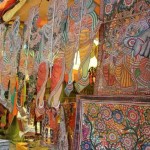India is home to a plethora of handlooms, weaves and handicrafts. While these are arts and crafts that are always in danger of succumbing to modern technology and getting buried under a sea of faster, quicker methods to manufacture; there are several that still survive and thrive. It’s a different feeling of owning a material that has been carefully put together and woven, and these seven ethic weaves, produced indigenously, have a particularly special feel about them. Take a look at a few before you shop for your next material.
1. BOMKAI HANDLOOM
Where it’s from: Subarnapur, Orissa
What you need to know: The starring feature of this gorgeous weave is the thread-work ornament borders that they use to make saris. The thread count is low, but the material is very popular because of the patterns created on it and the bright colors that it is dyed in. Often, patterns are woven in the material in contrasting colors, making the material stand out more than usual. Still wondering, whether the weave is for you? Well, it’s a weave that’s super popular amongst celebrities, so it’s probably time you give it a try.
2. MANGALAGIRI COTTON
Where it’s from: Guntur, Andhra Pradesh
What you need to know: It’s popularly used to create saris and is mostly characterized by tiny checks, sometimes stripes that you can barely see with your naked eye. The weave is extremely fine and usually finished off in really bright colors. The handlooms usually have a thread-count of 80-80 or 40-60, depending on how hard or soft the woven fabric is. The cloth usually falls under a crisp category, making the clothing items pretty stiff but very durable.
3. TUSSAR SILK
Where it’s from: Jharkhand
What you need to know: Have you heard of sericulture? It’s basically the production of fabric from the protein extracted out of the larvae of silkworms. This is how this gorgeous Indian weave is made, and the weaving produces a fabric in a natural gold color. This can be dyed of course, but it’s pretty gorgeous on its own as well, even with the heavy textures. The fabric can only be dry cleaned, and it’s both delicate as well as stiff, and this makes it fall beautifully when it’s used in an ethnic outfit. The rich, coarse texture may make it look heavy but it is light on your skin, which makes it perfect for the weather in India. In places like West Bengal, this handloom is used for Kantha embroidery. If you’re looking for something that’s similar to Tussar but much more comfortable and very light, you can pick Kosar (from Champa in Chhattisgarh). This is produced by a worm that is similar to the silk worm, so it’s not as exclusive. It’s soft, but sturdy so you know that clothes in this material will last you longer. It’s an all natural material, and even if you don’t want to use the original dull gold shade (very similar to Tussar) you can pick from the dyed options – and still stay natural as shades are usually made with pollen and flower by-products.
4. PAITHANI BROCADE
Where it’s from: Aurangabad, Maharashtra
What you need to know: The materials of this weave, whose name is based on the town that the art comes from (Paithan), are usually available as finished products in a variety of rainbow colors, making them one of the most fun weaves out there. However, since they’re made from extremely fine silk, they’re also one of the most luxurious and coveted types. The process to make this weave is a type of silk weaving, but what makes it such a highly sought after thing is the fact that it’s woven in with zari, which makes it look so shiny. Though there are cheaper varieties available, but it’s usually a pretty expensive piece to buy, often woven with colors going lengthwise and widthwise for a little variation causing a rainbow effect. The material takes longer than most (months on end) to be woven.
5. MAHESHWARI HANDLOOM
Where it’s from: Maheshwar, Madhya Pradesh
What you need to know: This is as royal as you’re going to get with an ethnic weave. The popular weave is made with silk or cotton threads that are usually combined together to make thicker threads, then woven into a really soft, gorgeous looking handloom piece. The end result is a dense weave, and while most other handlooms pop with bright colors, you will find these in softer, though bold shades of green or pink. Sometimes, checks and patterns are woven in with the material, making them even more distinctive as materials. This is also very popularly used to make salwar suits, apart from the saris that most ethnic weaves are best suited to.
6. POCHAMPALLY IKAT
Where it’s from: Hyderabad, Andhra Pradesh
What you need to know: While ikat is usually a type of dyeing, this takes place before it’s even woven, making it an intrinsic part of the weave itself. The ikat woven material is beautiful, and it’s a hand-done process that takes quite a while. It can be colored or uncolored and when they’re done as pochampally material, are attractively patterned as well. There are several motifs on the material. When pochampally is made into attire, it’s usually complemented by heavy ikat-printed borders as well. They are smoother and lighter than most hand woven textiles, and are pretty costly. There are several types of this process – namely warp, weft and double, so you can pick your type according to your budget, and whether you want the patterns to be as visible.
7. PATOLA WEAVE
Where it’s from: Patan, Gujarat
What you need to know: Just like ikat, this also is a weave involving print. However, the reason why this is such an important one on our list is, because the art is slowly dying out. That’s because it’s not a process that is taught to everyone, and is something that is so traditional. The process itself has never left the area of its origin - although imitations do exist. The method of weaving can’t be completely explained because of this, but we know that it’s pretty similar to the double ikat style and made from silk. What we can tell you is that the final product is available in an array of beautiful, bright colors, and that the weave is pretty tight, and a closely knit one, that’s often complemented by bright, Indian motifs and designs.
Nicole
Latest posts by Nicole (see all)
- 10 Breathtaking Treks That Come Alive With A Dip In The Temperature! - December 23, 2020
- 12 Essential Tips For an Incredible Trip To India - December 8, 2020
- 10 Indian Music Festivals You Should Go To While You Are Still Young (at heart)! - December 5, 2021





















